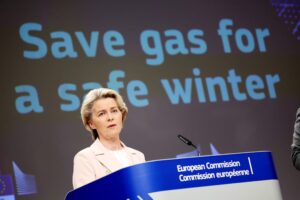Russia’s pipeline gas flows to Europe in June were flat month on month at 1.76 Bcm despite a week-long period of maintenance on the TurkStream pipeline, an analysis of data from S&P Global Commodity Insights showed July 4.
Russian deliveries into Europe by pipeline are currently limited to flows via Ukraine entering at the Sudzha point on the Russia-Ukraine border and via the European string of TurkStream.
Excluding supplies to the former Soviet state of Moldova, total Russian pipeline exports to Europe are still running much lower year on year, with June deliveries via the two remaining major supply routes down 63%.
The reliability of the remaining Russian gas exports to Europe also remains a concern, with the EU cautioning at the end of March that the total cessation of Russian flows to Europe in 2023 was still a possibility.
In addition, Russia’s five-year transit deal with Ukraine signed at the end of 2019 expires in December 2024 and is unlikely to be renewed, according to Ukrainian officials.
Russia’s pipeline supplies to Europe were gradually reduced through 2022, with deliveries halted via the Yamal-Europe and Nord Stream pipelines, and supplies sharply curtailed via Ukraine.
The two-string Nord Stream pipeline was subsequently hit by a suspected sabotage attack in late September, rendering the system unusable.
TurkStream work
Russian gas deliveries via TurkStream into Southeast Europe rose slightly in June month on month to 0.71 Bcm despite the pipeline being closed from June 5-11 for annual maintenance.
Supplies via TurkStream in May had totaled 0.7 Bcm, which was the lowest volume since June 2022.
By the end of June, TurkStream flows into Southeast Europe had reached 36 million cu m/d, the highest daily flow since April.
As well as Turkey itself, two of the main beneficiaries of gas via TurkStream are Hungary and Serbia, which both still have relatively close ties with Moscow.
Russia’s Gazprom said in April it would consider supplying additional gas to Hungary in 2023 and implementing a deferred payment mechanism for any extra gas deliveries.
Hungary agreed a 15-year deal in September 2021 with Gazprom for the supply of 4.5 Bcm/year of gas, but also imported additional volumes of Russian gas in August, September and October last year on top of contracted volumes as it looked to ensure security of supply ahead of the past winter.
Russian gas via TurkStream can also be delivered to Romania, Greece, North Macedonia, and Bosnia and Herzegovina.
Ukraine storage
Russian deliveries via Ukraine to non-CIS countries totaled 1.05 Bcm in June, down slightly from May, with supplies into Europe at the Velke Kapusany interconnection point averaging 35 million cu m/d.
There were also five days of reverse flow at Velke Kapusany in June, with gas staying in Ukraine for storage injection.
Storage operator UkrTransGaz said June 30 that Ukraine was already seeing gas storage injections by non-Ukrainian companies after Kyiv offered the use of more than 10 Bcm of spare Ukrainian gas storage capacity this summer.
EU gas storage sites are already 78% full, according to data from Gas Infrastructure Europe, and could top out well before the start of winter, bringing spare Ukrainian storage capacity into play.
Ukraine has a total of some 31 Bcm of underground gas storage capacity but it remains underutilized, with sites filled with 10.73 Bcm of gas as of July 2, according to S&P Global Commodity Insights data.
Earlier this month, grid operator GTSOU urged European traders to act “promptly” to make use of the country’s storage capacity in order to take advantage of current gas market conditions and the summer-winter spread.
Platts, part of S&P Global Commodity Insights, assessed the TTF Winter 2023 contract on July 3 at Eur49.55/MWh, a premium of Eur15.55/MWh to the TTF month-ahead price of Eur34/MWh.
Kyiv is also maintaining its “customs warehouse” regime, which allows European traders to store gas in Ukraine for 1,095 days without paying taxes and customs duties.
Source: SAP Global















